

Arduino & DevKit. Tutorial 11 for Arduino: SD Cards and Datalogging. HomePage. Clodiuno - Clojure API for Arduino (by Nurullah Akkaya) Arduino/Clodiuno – Hello world in morse. Getting Started with Arduino, 2nd Edition Data Science.

Getting Started with Netduino Data Science From basic statistics to machine learning and new ways to think about visualization, this kit gives you the tools you need to get started with data.

View the Titles Machine Learning Complete with tutorials, hands-on problem solving videos, and training—this kit has everything you need to get a solid foundation in machine learning. Make: Arduino Bots and Gadgets Data Science From basic statistics to machine learning and new ways to think about visualization, this kit gives you the tools you need to get started with data.

View the Titles Machine Learning Complete with tutorials, hands-on problem solving videos, and training—this kit has everything you need to get a solid foundation in machine learning. Projects. Welcome. Crash course: Embedded programming with Arduino. December 20, 2011, 8:00 AM — Demand for embedded programming is growing like crazy, so anyone looking for some job security might consider becoming an ace embedded programmer.
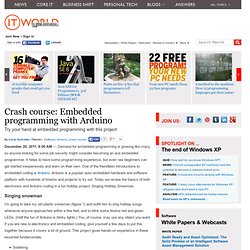
It helps to have some programming experience, but even raw beginners can get started inexpensively and learn on their own. One of the friendliest introductions to embedded coding is Arduino. Learning Ins and Outs of Arduino. Arduino is an open embedded hardware and software platform designed for rapid creativity.

It's both a great introduction to embedded programming and a fast track to building all kinds of cool devices like animatronics, robots, fabulous blinky things, animated clothing, games, your own little fabs... you can build what you imagine. Follow along as we learn both embedded programming and basic electronics. What Does Arduino Do? Arduino was invented by Massimo Banzi, a self-taught electronics guru who has been fascinated by electronics since childhood. Mr. The microprocessor revolution has removed a lot of barriers for newcomers, and considerably speeded up the pace of iteration. Arduino programming guide – part 1. This article originally appeared in issue 95 of Linux User & Developer magazine.
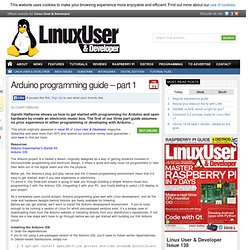
Subscribe and save more than 30% and receive our exclusive money back guarantee – click here to find out more. ResourcesArduino Experimenter’s Starter Kit Arduino IDE The Arduino project is a hacker’s dream: originally designed as a way of getting students involved in microcontroller programming and electronic design, it offers a quick and easy route for programmers to take their skills out of the digital realm and into the physical.
Better yet, the Arduino’s plug and play nature and the C-based programming environment mean that it’s easy to get started, even if you lack experience in electronics. Arduino and Ikea = Superb RGB LED Table Hack. Taking a stock Ikea table, this hacker added a set of 81 individually controlled RGB LEDs to the frame, creating a glowing livingroom centerpiece. Using the Arduino, he can individually address each LED to control the color change. Now if only it was a VU meter which bumped to the beat of your music…Perhaps that’s another project Above is a photo of the LED array beneath the table.
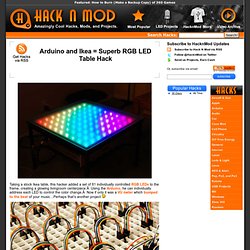
Definitely a superb job of cable management to say the least. More info on the project can be found on the author’s flickr page.  Finally, below is a video of the table in action. Do not miss out: Arduino Tutorial - Lesson 5. We've done a lot so far, blinking lights, printing messages...all of that stuff is output: signals coming from the Arduino.
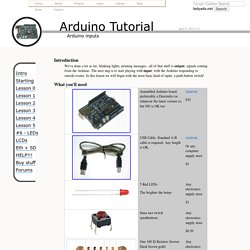
The next step is to start playing with input, with the Arduino responding to outside events. In this lesson we will begin with the most basic kind of input, a push-button switch! You're probably familiar with switches, there's tons of them in your house. One kind of switch you use every day is a light switch. A light switch is a simple device with two positions, on and off. On the left, the switch is open and no current flows. (thanks wikipedia!)
In this photo, you can see the internals of a light switch. Light switches are great but we need something smaller. These little switches are a 1/4" on each side, cost about 25 cents, and can plug directly into a breadboard. Normally, the two wires are disconnected (normally open) but when you press the little button on top, they are mechanically connected. Find 5 things around the house that have switches. Buy. .:oomlout:. Arduino & DIY Electronics and kits in the UK. SK Pang Electronics, Arduino, Sparkfun, GPS, GSM. Maker SHED. Adafruit Industries, Unique & fun DIY electronics and kits. News. Pinguino, open source hardware electronics prototyping platform based on 8- and 32-bit PIC from Microchip. Arduino « Search Results « ID's blog. The speed of the sound in the dry air (20° C) is around 343 m/s.
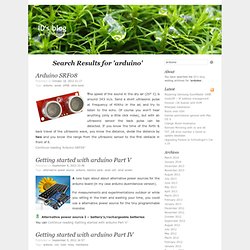
Send a short ultrasonic pulse at Frequency of 40Khz in the air, and try to listen to the echo. Of course you won’t hear anything (only a little click noise), but with an ultrasonic sensor the back pulse can be detected. If you know the time of the forth & back travel of the ultrasonic wave, you know the distance, divide the distance by two and you know the range from the ultrasonic sensor to the first obstacle in front of it.
Continue reading ‘Arduino SRF08′ A new topic about about alternative power sources for the arduino board (in my case arduino duemilanove version). For measurements and experimentations outdoor or while you sitting in the train and wasting your time, you could use a alternative power source for the tiny programmable monster. Alternative power source I – battery’s/rechargeable batteries You can Continue reading ‘Getting started with arduino Part V’